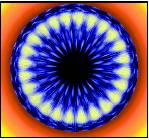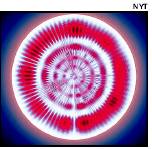These images are actually whale songs!!!
Written on Friday, August 04, 2006 by Gemini
What do whale songs and wavelets have in common? Quite a bit, and the wavelets have nothing to do with water. In a Northern California studio, Mark Fischer, an engineer by training, uses wavelets—a technique for processing digital signals—to transform the haunting calls of ocean mammals into movies that visually represent the songs and still images that look like electronic mandalas.
TUNES IN PICTURES: Mark Fischer found a mathematical tool to translate nuances of whale and dolphin sounds into mandala-like images 
Fischer learned about acoustics by developing software for Navy sonar and the telecommunications industry. Years later, a serendipitous brush with whale researchers in Baja California led him to take a closer look at whales and the diversity of their intricate communication. “I don’t think anyone has ever spent even a little time around a whale and not been amazed by it,” Fischer said.
Fischer creates visual art from sound using wavelets. Once relatively obscure, wavelets are being used in applications as diverse as JPEG image compression, high definition TV and earthquake research, said Gilbert Strang, a math professor at the Massachusetts Institute of Technology and a wavelets expert.
They are popular now in part because they can capture intricate detail without losing the bigger picture, and when presented in circular form (using a cylindrical coordinate system), repeated patterns are even more evident. By stringing successive images together, Fischer transforms still images into animated audio files that bring the sound to life. 
Among whales, certain sounds and patterns are unique to different species, and even individuals in a group—something like an auditory fingerprint, Fischer said. “To anyone who doesn’t listen to it on a regular basis it sounds like a bunch of clicks,” he said. “But if you’re a whale, or someone who studies whales it becomes clear that they have their own dialects.” Wavelets are capable of picking up those distinctions, Fischer said, nuances that may be missed by the human ear or less detailed visualisation methods.

